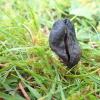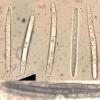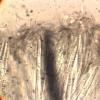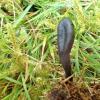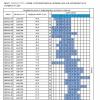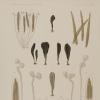
13-10-2023 14:56
Dragiša SavicHi to allI think this Scutellinia is different fro

16-10-2023 01:05
Stefan JakobssonFive weeks ago I found Anthracobia tristis and A.

20-10-2023 11:57
Ursula KozikHello and good day, looking for a description of

01-10-2023 14:57
Michael ValentineHello,Found on Friday, in the middle of an isolate

17-10-2023 13:04
Watt JohnThese asci, from mixed woodland in western england

18-10-2023 14:56
 Stoykov Dimitar
Stoykov Dimitar
Hallo,I have collected an interesting stromatic fu
Geoglossum
Malcolm Greaves,
15-11-2020 13:00
The spores were all hyaline and none septate on the two spore drops I did but there were some slightly darker spores with a few septa still in situ on the fruit body. The paraphyses some cylindrical and some slightly swollen and curved. They also looked to be embeded in a dark material. This was leading me towards G fallax which I have found discharge hyaline spores and sometimes have the paraphyses in this darker material.
When the spores were measured they were all in the range 50-65 so this excluded fallax but brought up Hemileucoglossum littorale.
Thanks for any thoughts.
Mal
Lothar Krieglsteiner,
15-11-2020 13:08

Re : Geoglossum
Hi Malcolm,
shortly I also had G. fallax that bothered me because of its very long-staying unripeness (hyaline color) of the spores. I also was thinking about Hemileucoglossum and others, but finally I found some few asci with dark and partly septate spores, and a section of the typically rough stipe surface clearly showed no setae.
And I am not sure, if the shortness of the unripe spores really excludes fallax - ripe spores often are larger than unripe ones.
Question: how does the stipe of your earth tongue look?
Best regards, Lothar
shortly I also had G. fallax that bothered me because of its very long-staying unripeness (hyaline color) of the spores. I also was thinking about Hemileucoglossum and others, but finally I found some few asci with dark and partly septate spores, and a section of the typically rough stipe surface clearly showed no setae.
And I am not sure, if the shortness of the unripe spores really excludes fallax - ripe spores often are larger than unripe ones.
Question: how does the stipe of your earth tongue look?
Best regards, Lothar
Björn Sothmann,
15-11-2020 13:34

Re : Geoglossum
Hi Malcom,
have you compared to Geoglossum elongatum? According to Roobeek Aardtongen in de duinen van Noord-Kennemerland 2005 T/M 2008 (2009), it is the second Geoglossum species apart from G. fallax that regularly produces unripe spores in a spore print but has spore lengths mostly in the range from 50-70 µm.
Best,
Björn
Malcolm Greaves,
15-11-2020 16:32
Malcolm Greaves,
15-11-2020 16:38
Re : Geoglossum
Björn
I hadn't looked at G elongatum and in many respects that does look good. The description of the shape of the paraphyses varies from one author to the next. They are described as cylindrical (Priou) which would be good but some of the more recent papers such as Hustad have them as contorted which mine weren't but I will have a closer look.
Thanks
Mal
I hadn't looked at G elongatum and in many respects that does look good. The description of the shape of the paraphyses varies from one author to the next. They are described as cylindrical (Priou) which would be good but some of the more recent papers such as Hustad have them as contorted which mine weren't but I will have a closer look.
Thanks
Mal
Luc Lenaerts,
16-11-2020 11:24
Re : Geoglossum
Hello,
In my opinion it's an unripe Geoglossum fallax. Very many, well-developed fruiting bodies of Geoglossum fallax in Flanders (Belgium), especially on sandy soils, have septate (free) spores in a crushing preparation often with maximum 7 septa. The ripening of the spores often stops at 7-septate spores. The average length of the septate spores in my 200 collections goes from 56.8 µm to 85.7 µm. The average length of the aseptate spores in the spore print goes from 52.0 to 90.4 µm. I studied specimens of the holotype of Geoglossum elongatum. The average length of the septate, olive tot olive brown spores (1- to 7-septate) in this specimens goes from 47.8 to 52.2 µm. I see no difference between the paraphyses of both species. Spore sizes for Geoglossum fallax according to Mains (1954) are: (45-) 66-90 (-110) x 5-6 µm, and according to Benkert (1976): (41-) 61-82 (-102) x (5-) 5,4-6,1 (-7) µm. In my opinion it is impossible to separate G. elongatum and G. fallax based on spore sizes and/or septation of the spores.
Kind regards
Luc Lenaerts
In my opinion it's an unripe Geoglossum fallax. Very many, well-developed fruiting bodies of Geoglossum fallax in Flanders (Belgium), especially on sandy soils, have septate (free) spores in a crushing preparation often with maximum 7 septa. The ripening of the spores often stops at 7-septate spores. The average length of the septate spores in my 200 collections goes from 56.8 µm to 85.7 µm. The average length of the aseptate spores in the spore print goes from 52.0 to 90.4 µm. I studied specimens of the holotype of Geoglossum elongatum. The average length of the septate, olive tot olive brown spores (1- to 7-septate) in this specimens goes from 47.8 to 52.2 µm. I see no difference between the paraphyses of both species. Spore sizes for Geoglossum fallax according to Mains (1954) are: (45-) 66-90 (-110) x 5-6 µm, and according to Benkert (1976): (41-) 61-82 (-102) x (5-) 5,4-6,1 (-7) µm. In my opinion it is impossible to separate G. elongatum and G. fallax based on spore sizes and/or septation of the spores.
Kind regards
Luc Lenaerts
Lothar Krieglsteiner,
16-11-2020 11:31

Re : Geoglossum
Hello Luc,
"In my opinion it is impossible to separate G. elongatum and G. fallax based on spore sizes and/or septation of the spores."
... then do you think both taxa are identical? Because you also write the paraphyses are the same.
Best regards, Lothar
"In my opinion it is impossible to separate G. elongatum and G. fallax based on spore sizes and/or septation of the spores."
... then do you think both taxa are identical? Because you also write the paraphyses are the same.
Best regards, Lothar
Björn Sothmann,
16-11-2020 11:34

Re : Geoglossum
Hi Luc,
I have basically the same question as Lothar - and maybe a partial answer to it. It seems that in your analysis you focus on the average spore length in your collections. Have you looked at the distributions of spore lengths? In the Dutch publication I mentioned above, it seems like there are clear differences between G. fallax and G. elongatum if you compare the full distribution of lengths.
Björn
Luc Lenaerts,
16-11-2020 11:39
Re : Geoglossum
Hello,
I only made a morphological study of the earth tonges of Flanders (publication in preparation). The answer to your question must be given by genetic research.
Kind regards
Luc Lenaerts
I only made a morphological study of the earth tonges of Flanders (publication in preparation). The answer to your question must be given by genetic research.
Kind regards
Luc Lenaerts
Lothar Krieglsteiner,
16-11-2020 11:42

Re : Geoglossum
thanks, Luc! Sure: the DNA must speak, as always. But fpr the moment: a species that cannot be separated morphologically is at least not a very good species ....
Best regards, Lothar
Best regards, Lothar
Luc Lenaerts,
16-11-2020 12:29
Re : Geoglossum
I am sending you some tables in which 36 specimens were examined in depth.
Figure 7 shows the distribution of the septation of the spores with increasing average spore length of the septated spores in this 36 specimens.
Figure 8A shows the spore measurements for the same specimens arranged according to increasing average spore length of the septated spores; in Figure 8B the spore measurements of the aseptate spores in the spore prints.
Only the spore sizes of the green colored specimens agree well with the original description of G. fallax. What do we do with the other ones? In my opinion they do not fit the description of G. elongatum.
Kind regards
Luc Lenaerts
Figure 7 shows the distribution of the septation of the spores with increasing average spore length of the septated spores in this 36 specimens.
Figure 8A shows the spore measurements for the same specimens arranged according to increasing average spore length of the septated spores; in Figure 8B the spore measurements of the aseptate spores in the spore prints.
Only the spore sizes of the green colored specimens agree well with the original description of G. fallax. What do we do with the other ones? In my opinion they do not fit the description of G. elongatum.
Kind regards
Luc Lenaerts
Malcolm Greaves,
16-11-2020 17:23
Re : Geoglossum
Thanks for all this input Luc very informative.
You say fallax and elongatum have the same paraphyses so you don't feel that elongatum has the contorted paraphyses tips mentioned by some authors?
Mal
You say fallax and elongatum have the same paraphyses so you don't feel that elongatum has the contorted paraphyses tips mentioned by some authors?
Mal
Luc Lenaerts,
17-11-2020 11:06
Malcolm Greaves,
21-11-2020 00:03
Re : Geoglossum
As I have never seen littorale I was unsure of all the distinguishing features. I was told to check the stem for dark setae, as a mark of littorale. There were none found so G fallax with spores shorter than I was expecting.
Thanks for all your help.
Mal
Thanks for all your help.
Mal


